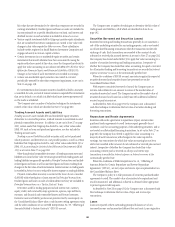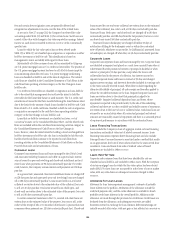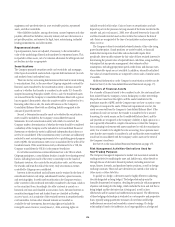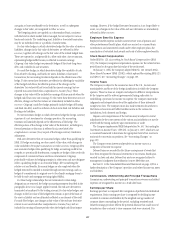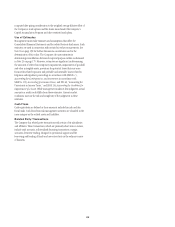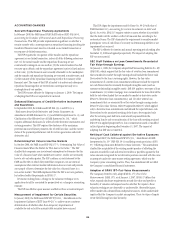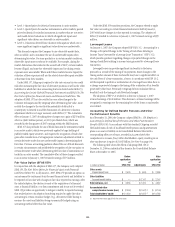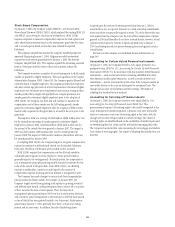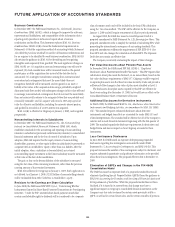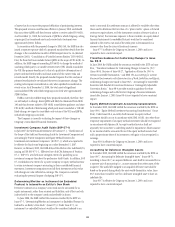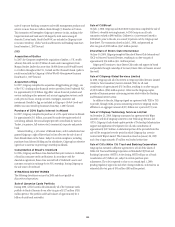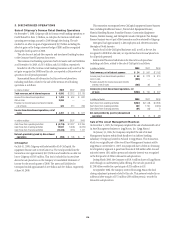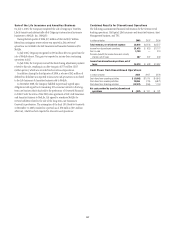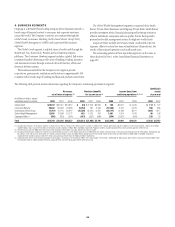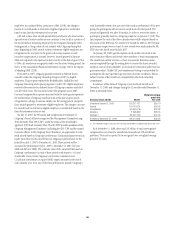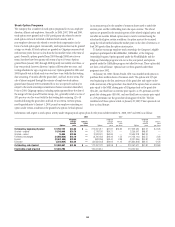Citibank 2008 Annual Report Download - page 139
Download and view the complete annual report
Please find page 139 of the 2008 Citibank annual report below. You can navigate through the pages in the report by either clicking on the pages listed below, or by using the keyword search tool below to find specific information within the annual report.of assets that do not meet the proposed definition of participating interests.
This proposed revision could become effective in January 2010 and should
this occur these QSPEs will then become subject to review under FIN 46(R).
As of December 31, 2008, the total assets of QSPEs to which Citigroup, acting
as principal, has transferred assets and received sales treatment were
approximately $822.1 billion.
In connection with the proposed changes to SFAS 140, the FASB has also
issued a separate exposure draft of a proposed standard that details three key
changes to the consolidation model in FASB Interpretation No. 46 (Revised
December 2003), “Consolidation of Variable Interest Entities” [FIN 46(R)].
First, the Board will now include former QSPEs in the scope of FIN 46(R). In
addition, the FASB supports amending FIN 46(R) to change the method of
analyzing which party to a variable interest entity (VIE) should consolidate
the VIE (the primary beneficiary) to that of a qualitative determination of
power combined with benefits and losses instead of the current risks and
rewards model. Finally, the proposed standard requires that the analysis of
primary beneficiaries be reevaluated whenever circumstances change. The
existing rules require reconsideration only when specified reconsideration
events occur. As of December 31, 2008, the total assets of significant
unconsolidated VIEs with which Citigroup is involved were approximately
$288.0 billion.
FASB is currently redeliberating these proposed standards; therefore, they
are still subject to change. Since QSPEs will likely be eliminated from SFAS
140 and thus become subject to FIN 46(R) consolidation guidance and since
FIN 46(R)’s method of determining which party must consolidate a VIE will
likely change, we expect to consolidate only certain of the VIEs and QSPEs,
with which Citigroup is involved.
The Company is currently evaluating the impact of these changes on
Citigroup’s Consolidated Financial Statements.
Investment Company Audit Guide (SOP 07-1)
In July 2007, the AICPA issued Statement of Position 07-1, “Clarification of
the Scope of the Audit and Accounting Guide for Investment Companies and
Accounting by Parent Companies and Equity Method Investors for
Investments in Investment Companies” (SOP 07-1), which was expected to
be effective for fiscal years beginning on or after December 15, 2007.
However, in February 2008, the FASB delayed the effective date indefinitely by
issuing an FSP SOP 07-1-1, “Effective Date of AICPA Statement of Position
07-1.” SOP 07-1 sets forth more stringent criteria for qualifying as an
investment company than does the predecessor Audit Guide. In addition, SOP
07-1 establishes new criteria for a parent company or equity method investor
to retain investment company accounting in their consolidated financial
statements. Investment companies record all their investments at fair value
with changes in value reflected in earnings. The Company is currently
evaluating the potential impact of adopting SOP 07-1.
Determining Whether an Instrument (or Embedded
Feature) Is Indexed to an Entity’s Own Stock
Derivative contracts on a company’s own stock may be accounted for as
equity instruments, rather than as assets and liabilities, only if they are both
indexed solely to the company’s stock and settleable in shares.
In June 2008, the FASB ratified the consensus reached by the EITF on
Issue 07-5, “Determining Whether an Instrument (or Embedded Feature) Is
Indexed to an Entity’s Own Stock” (Issue 07-5). Under Issue 07-5, an
instrument (or embedded feature) would not be considered indexed to an
entity’s own stock if its settlement amount is affected by variables other than
those used to determine the fair value of a “plain vanilla” option or forward
contract on equity shares, or if the instrument contains a feature (such as a
leverage factor) that increases exposure to those variables. An equity-linked
financial instrument (or embedded feature) would not be considered
indexed to the entity’s own stock if the strike price is denominated in a
currency other than the issuer’s functional currency.
Issue 07-5 is effective for Citigroup on January 1, 2009, and is not
expected to have a material impact.
Transition Guidance for Conforming Changes to Issue
No. 98-5
In June 2008, the FASB ratified the consensus reached by the EITF on Issue
08-4, “Transition Guidance for Conforming Changes to Issue No. 98-5”
(Issue 08-4). Because of Issue 00-27, “Application of Issue No. 98-5 to
Certain Convertible Instruments,” and SFAS 150, Accounting for Certain
Financial Instruments with Characteristics of both Liabilities and Equity,
conforming changes were made to Issue 98-5, “Accounting for Convertible
Securities with Beneficial Conversion Features or Contingently Adjustable
Conversion Ratios.” Issue 08-4 provides transition guidance for those
conforming changes and is effective for Citigroup’s financial statements
issued after January 1, 2009. Issue 08-4 is not expected to have a material
impact.
Equity Method Investment Accounting Considerations
In November 2008, the FASB ratified the consensus reached by the EITF on
Issue 08-6, “Equity Method Investment Accounting Considerations” (Issue
08-6). Under Issue 08-6, an entity shall measure its equity method
investment initially at cost in accordance with SFAS 141(R). Any other-than-
temporary impairment of an equity method investment should be recognized
in accordance with Opinion 18. An equity method investor shall not
separately test an investee’s underlying assets for impairment. Share issuance
by an investee shall be accounted for as if the equity method investor had
sold a proportionate share of its investment, with gain or loss recognized in
earnings.
Issue 08-6 is effective for Citigroup on January 1, 2009, and is not
expected to have a material impact.
Accounting for Defensive Intangible Assets
In November 2008, the FASB ratified the consensus reached by the EITF on
Issue 08-7, “Accounting for Defensive Intangible Assets” (Issue 08-7).
According to Issue 08-7, an acquired defensive asset shall be accounted for as
a separate unit of accounting (i.e., an asset separate from other assets of the
acquirer). The useful life assigned to an acquired defensive asset shall be
based on the period during which the asset would diminish in value. Issue
08-7 states that it would be rare for a defensive intangible asset to have an
indefinite life.
Issue 08-7 is effective for Citigroup on January 1, 2009, and is not
expected to have a material impact.
133


